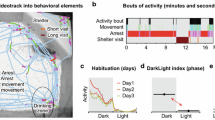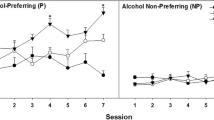Abstract
Rationale
Sensitization to the locomotor stimulant effects of alcohol (ethanol) is thought to be a heritable risk factor for the development of alcoholism that reflects progressive increases in the positive motivational effects of this substance. However, very little is known about the degree to which genes influence this complex behavioral phenomenon.
Objectives
The primary goal of this work was to determine the heritability of ethanol-induced locomotor sensitization in mice using short-term behavioral selection.
Methods
Genetically heterogeneous C57BL/6J (B6) × DBA/2J (D2) F2 mice were generated from B6D2F1 progenitors, phenotyped for the expression of locomotor sensitization, and bred for high (HLS) and low (LLS) expression of this behavior. Selective breeding was conducted in two independently generated replicate sets to increase the confidence of our heritability estimates and for future correlated trait analyses.
Results
Large and significant differences in locomotor sensitization between HLS and LLS lines were evident by the fourth generation. Twenty-two percent of the observed line difference(s) were attributable to genes (h 2 = .22). Interestingly, locomotor activity in the absence of ethanol was genetically correlated with ethanol sensitization; high activity was associated with high sensitization.
Conclusions
That changes in ethanol sensitivity following repeated exposures are genetically regulated highlights the relevance of studies aimed at determining how genes regulate susceptibility to ethanol-induced behavioral and neural adaptations. As alcohol use and abuse disorders develop following many repeated alcohol exposures, these data emphasize the need for future studies determining the genetic basis by which changes in response to alcohol occur.




Similar content being viewed by others
References
Bardo MT, Donohew RL, Harrington NG (1996) Psychobiology of novelty seeking and drug seeking behavior. Behav Brain Res 77:23–43
Belin D, Berson N, Balado E, Piazza PV, Deroche-Gamonet V (2011) High-novelty-preference rats are predisposed to compulsive cocaine self-administration. Neuropsychopharmacology 36:569–579
Belknap JK, Richards SP, O’Toole LA, Helms ML, Phillips TJ (1997) Short-term selective breeding as a tool for QTL mapping: ethanol preference drinking in mice. Behav Genet 27:55–66
Bennett ME, McCrady BS, Johnson V, Pandina RJ (1999) Problem drinking from young adulthood to adulthood: patterns, predictors and outcomes. J Stud Alcohol 60:605–614
Boehm SL 2nd, Goldfarb KJ, Serio KM, Moore EM, Linsenbardt DN (2008) Does context influence the duration of locomotor sensitization to ethanol in female DBA/2J mice? Psychopharmacology (Berl) 197:191–201
Cain ME, Saucier DA, Bardo MT (2005) Novelty seeking and drug use: contribution of an animal model. Exp Clin Psychopharmacol 13:367–375
Crabbe JC (1989) Genetic animal models in the study of alcoholism. Alcohol Clin Exp Res 13:120–127
Crabbe JC (2008) Review. Neurogenetic studies of alcohol addiction. Philosophical transactions of the Royal Society of London Series B. Biol Sci 363:3201–3211
Crabbe JC, Metten P, Rhodes JS, Yu CH, Brown LL, Phillips TJ, Finn DA (2009) A line of mice selected for high blood ethanol concentrations shows drinking in the dark to intoxication. Biol Psychiatry 65:662–670
Crabbe JC, Phillips TJ, Kosobud A, Belknap JK (1990) Estimation of genetic correlation: interpretation of experiments using selectively bred and inbred animals. Alcohol Clin Exp Res 14:141–151
Cunningham CL (1995) Localization of genes influencing ethanol-induced conditioned place preference and locomotor activity in BXD recombinant inbred mice. Psychopharmacology (Berl) 120:28–41
Cunningham CL, Tull LE, Rindal KE, Meyer PJ (2002) Distal and proximal pre-exposure to ethanol in the place conditioning task: tolerance to aversive effect, sensitization to activating effect, but no change in rewarding effect. Psychopharmacology (Berl) 160:414–424
Dick DM, Bierut LJ (2006) The genetics of alcohol dependence. Curr Psychiatry Rep 8:151–157
Didone V, Quoilin C, Tirelli E, Quertemont E (2008) Parametric analysis of the development and expression of ethanol-induced behavioral sensitization in female Swiss mice: effects of dose, injection schedule, and test context. Psychopharmacology (Berl) 201:249–260
Enoch MA, Goldman D (2001) The genetics of alcoholism and alcohol abuse. Curr Psychiatry Rep 3:144–151
Falconer DS (1989) Introduction to Quantitative Genetics, Longman, New York
Falconer DS, Mackay TFC (1996) Introduction to quantitative genetics (4th ed.). Essex, England: Longman Group
Frye GD, Breese GR (1981) An evaluation of the locomotor stimulating action of ethanol in rats and mice. Psychopharmacology (Berl) 75:372–379
Gingras MA, Cools AR (1995) Differential ethanol intake in high and low responders to novelty. Behav Pharmacol 6:718–723
Gotham HJ, Sher KJ, Wood PK (1997) Predicting stability and change in frequency of intoxication from the college years to beyond: individual-difference and role transition variables. J Abnorm Psychol 106:619–629
Hasin DS, Grant B, Endicott J (1990) The natural history of alcohol abuse: implications for definitions of alcohol use disorders. Am J Psychiatry 147:1537–1541
Heath AC, Bucholz KK, Madden PA, Dinwiddie SH, Slutske WS, Bierut LJ, Statham DJ, Dunne MP, Whitfield JB, Martin NG (1997) Genetic and environmental contributions to alcohol dependence risk in a national twin sample: consistency of findings in women and men. Psychol Med 27:1381–1396
Holdstock L, King AC, de Wit H (2000) Subjective and objective responses to ethanol in moderate/heavy and light social drinkers. Alcohol Clin Exp Res 24:789–794
Hunt WA, Lands WE (1992) A role for behavioral sensitization in uncontrolled ethanol intake. Alcohol 9:327–328
Johnson EO, van den Bree MB, Gupman AE, Pickens RW (1998) Extension of a typology of alcohol dependence based on relative genetic and environmental loading. Alcohol Clin Exp Res 22:1421–1429
Kalinichev M, White DA, Holtzman SG (2004) Individual differences in locomotor reactivity to a novel environment and sensitivity to opioid drugs in the rat I. Expression of morphine-induced locomotor sensitization. Psychopharmacology (Berl) 177:61–67
King AC, de Wit H, McNamara PJ, Cao D (2011) Rewarding, stimulant, and sedative alcohol responses and relationship to future binge drinking. Arch Gen Psychiatry 68:389–399
King AC, Volpicelli JR, Frazer A, O’Brien CP (1997) Effect of naltrexone on subjective alcohol response in subjects at high and low risk for future alcohol dependence. Psychopharmacology (Berl) 129:15–22
Knopik VS, Heath AC, Madden PA, Bucholz KK, Slutske WS, Nelson EC, Statham D, Whitfield JB, Martin NG (2004) Genetic effects on alcohol dependence risk: re-evaluating the importance of psychiatric and other heritable risk factors. Psychol Med 34:1519–1530
Laviola G, Macri S, Morley-Fletcher S, Adriani W (2003) Risk-taking behavior in adolescent mice: psychobiological determinants and early epigenetic influence. Neurosci Biobehav Rev 27:19–31
Linsenbardt DN, Boehm SL II (2010a) Ethanol-induced locomotor sensitization in DBA/2J mice is associated with alterations in GABA(A) subunit gene expression and behavioral sensitivity to GABA(A) acting drugs. Pharmacol Biochem Behav 95:359–366
Linsenbardt DN, Boehm SL II (2010b) Sensitization to ethanol-induced locomotor responses in 8 inbred mouse strains. Alcohol Clin Exp Res 34(suppl2):190A
McClearn GE, Kakihana R (1981) Selective breeding for ethanol sensitivity: short-sleep and long-sleep mice, in McClearn, G.E., Deitrich R.A., Erwin V.G. (eds): Development of animal models as pharmacogenetic tools. Washington, NIAAA Research Monograph No. 6, US Govt Printing Office, pp 147-159
Metten P, Crabbe JC (2005) Alcohol withdrawal severity in inbred mouse (Mus musculus) strains. Behav Neurosci 119:911–925
Mitchell JM, Cunningham CL, Mark GP (2005) Locomotor activity predicts acquisition of self-administration behavior but not cocaine intake. Behav Neurosci 119:464–472
Nadal R, Armario A, Janak PH (2002) Positive relationship between activity in a novel environment and operant ethanol self-administration in rats. Psychopharmacology (Berl) 162:333–338
Newlin DB, Thomson JB (1990) Alcohol challenge with sons of alcoholics: a critical review and analysis. Psychol Bull 108:383–402
Newlin DB, Thomson JB (1991) Chronic tolerance and sensitization to alcohol in sons of alcoholics. Alcohol Clin Exp Res 15:399–405
Newlin DB, Thomson JB (1999) Chronic tolerance and sensitization to alcohol in sons of alcoholics: II. Replication and reanalysis. Exp Clin Psychopharmacol 7:234–243
Phillips TJ (1997) Behavior genetics of drug sensitization. Crit Rev Neurobiol 11:21–33
Phillips TJ, Broadbent J, Burkhart-Kasch S, Henderson C, Wenger CD, McMullin C, McKinnon CS, Cunningham CL (2005) Genetic correlational analyses of ethanol reward and aversion phenotypes in short-term selected mouse lines bred for ethanol drinking or ethanol-induced conditioned taste aversion. Behav Neurosci 119:892–910
Phillips TJ, Huson M, Gwiazdon C, Burkhart-Kasch S, Shen EH (1995) Effects of acute and repeated ethanol exposures on the locomotor activity of BXD recombinant inbred mice. Alcohol Clin Exp Res 19:269–278
Phillips TJ, Lessov CN, Harland RD, Mitchell SR (1996) Evaluation of potential genetic associations between ethanol tolerance and sensitization in BXD/Ty recombinant inbred mice. J Pharmacol Exp Ther 277:613–623
Phillips TJ, Roberts AJ, Lessov CN (1997) Behavioral sensitization to ethanol: genetics and the effects of stress. Pharmacol Biochem Behav 57:487–493
Piazza PV, Deminiere JM, Le Moal M, Simon H (1989) Factors that predict individual vulnerability to amphetamine self-administration. Science 245:1511–1513
Prescott CA, Neale MC, Corey LA, Kendler KS (1997) Predictors of problem drinking and alcohol dependence in a population-based sample of female twins. J Stud Alcohol 58:167–181
Risinger FO, Dickinson SD, Cunningham CL (1992) Haloperidol reduces ethanol-induced motor activity stimulation but not conditioned place preference. Psychopharmacology (Berl) 107:453–456
Robinson TE, Berridge KC (1993) The neural basis of drug craving: an incentive-sensitization theory of addiction. Brain Res Brain Res Rev 18:247–291
Spear LP (2000) The adolescent brain and age-related behavioral manifestations. Neurosci Biobehav Rev 24:417–463
Suto N, Austin JD, Vezina P (2001) Locomotor response to novelty predicts a rat’s propensity to self-administer nicotine. Psychopharmacology (Berl) 158:175–180
The National Academic Press (2003) Guidelines for the Care and Use of Mammals in Neuroscience and Behavioral Research
Wise RA, Bozarth MA (1987) A psychomotor stimulant theory of addiction. Psychol Rev 94:469–492
Young SE, Stallings MC, Corley RP, Krauter KS, Hewitt JK (2000) Genetic and environmental influences on behavioral disinhibition. Am J Med Genet 96:684–695
Acknowledgments
This work was supported by NIAAA grant nos. AA015434 (SLB), AA016789 (SLB), and AA07462 (DNL). Special thanks to Heather Sissons for assistance with animal husbandry.
Author information
Authors and Affiliations
Corresponding author
Rights and permissions
About this article
Cite this article
Linsenbardt, D.N., Boehm, S.L. Determining the heritability of ethanol-induced locomotor sensitization in mice using short-term behavioral selection. Psychopharmacology 230, 267–278 (2013). https://doi.org/10.1007/s00213-013-3151-4
Received:
Accepted:
Published:
Issue Date:
DOI: https://doi.org/10.1007/s00213-013-3151-4




